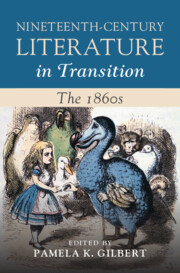Book contents
- Nineteenth-Century Literature in Transition: The 1860s
- Nineteenth-Century Literature in Transition
- Nineteenth-Century Literature in Transition: The 1860s
- Copyright page
- Contents
- Figures
- Contributors
- Introduction
- Chapter 1 Realism and Psychology
- Chapter 2 Sensational Bodies
- Chapter 3 Irish Rebellion on the Sensational Stage
- Chapter 4 Palgrave’s Golden Treasury
- Chapter 5 Impossible Monsters, Rabbit Holes, and New Worlds
- Chapter 6 Periodicals, Popular Fiction, and the Affordances of Digital Collections
- Chapter 7 Publishing in the 1860s
- Chapter 8 Italy in Transition
- Chapter 9 Silent Center, Vocal Margins
- Chapter 10 Empire and Evidence in Armadale and the Morant Bay Rebellion
- Chapter 11 Reading the Nonevental
- Chapter 12 An Age of Mythmaking
- Chapter 13 Reimagining Society
- Chapter 14 Historical Ecologies in Heterodox Economic Thought and Literary Realism of the 1860s
- Chapter 15 Extraction, Exhaustion, and the Sensation Novel of the 1860s
- Chapter 16 Evolution and the Human
- Bibliography
- Index
Chapter 11 - Reading the Nonevental
The Victorian Literary Sketch, Colonial Urbanity, and the Transimperial
Published online by Cambridge University Press: 01 February 2024
- Nineteenth-Century Literature in Transition: The 1860s
- Nineteenth-Century Literature in Transition
- Nineteenth-Century Literature in Transition: The 1860s
- Copyright page
- Contents
- Figures
- Contributors
- Introduction
- Chapter 1 Realism and Psychology
- Chapter 2 Sensational Bodies
- Chapter 3 Irish Rebellion on the Sensational Stage
- Chapter 4 Palgrave’s Golden Treasury
- Chapter 5 Impossible Monsters, Rabbit Holes, and New Worlds
- Chapter 6 Periodicals, Popular Fiction, and the Affordances of Digital Collections
- Chapter 7 Publishing in the 1860s
- Chapter 8 Italy in Transition
- Chapter 9 Silent Center, Vocal Margins
- Chapter 10 Empire and Evidence in Armadale and the Morant Bay Rebellion
- Chapter 11 Reading the Nonevental
- Chapter 12 An Age of Mythmaking
- Chapter 13 Reimagining Society
- Chapter 14 Historical Ecologies in Heterodox Economic Thought and Literary Realism of the 1860s
- Chapter 15 Extraction, Exhaustion, and the Sensation Novel of the 1860s
- Chapter 16 Evolution and the Human
- Bibliography
- Index
Summary
Kaliprasanna Sinha’s Hutom Pyanchar Naksha (Observations of Hutom the Owl[GK14]; 1862) provides a bird’s eye view, so to speak, of nineteenth-century Calcutta, the bustling metropolis that also served as the seat of the British government in India. In reading the vignettes of urban life that the text proffers, this essay makes note of Sinha’s even-handed satire of the foibles of natives and the British alike. But given that it is the nouveau riche Bengali gentry that becomes the target for Sinha’s most trenchant critique, the essay considers how Hutom[GK15], written in the aftermath of 1857, an event that Sinha often refers to, presents, nonetheless, a more lateral view that redirects, if not displaces, received notions of colonial resistance. Hutom [GK16]affects, instead, a charged insouciance that revels in its immediate socius that it also critique. It does so, though, by deploying the form of the literary sketch and a narrative mode that is antinarrative or, more specifically – nonevental – in ways that are transimperially imbricated with nineteenth-century literary history, English as well as Bengali.
Keywords
- Type
- Chapter
- Information
- Nineteenth-Century Literature in Transition: The 1860s , pp. 203 - 218Publisher: Cambridge University PressPrint publication year: 2024



